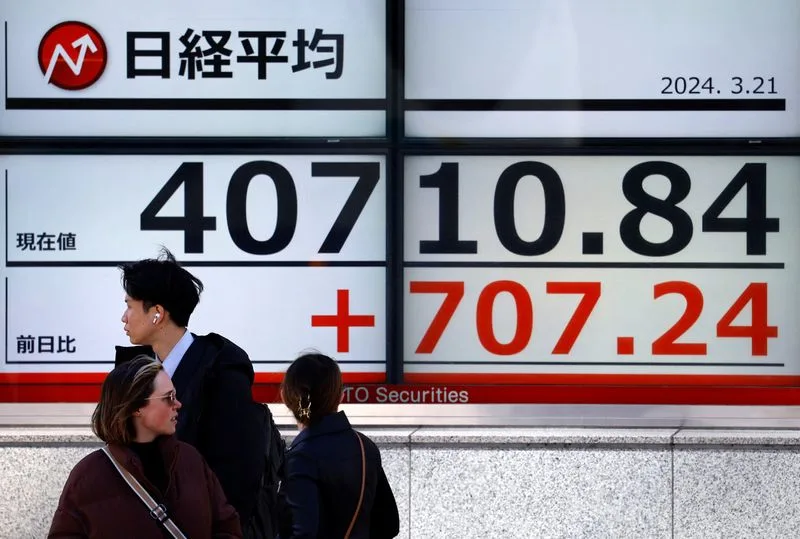Asian stocks surged on Thursday, with bond yields falling, as investors assessed the impact of cooling U.S. inflation and a more hawkish stance by the Federal Reserve. Japanese shares performed weaker, and the yen weakened slightly against the dollar as the Bank of Japan held its two-day policy meeting. The broadest index of Asia-Pacific shares outside Japan rose by 0.9%, with Taiwan stocks surging by 1.7% and Hong Kong’s Hang Seng increasing by almost 1%. This positive sentiment was driven by the U.S. S&P 500 and Nasdaq closing at record highs the previous day. U.S. futures indicated further gains, with S&P futures up by 0.2% and Nasdaq futures up by 0.6%. The Nikkei in Japan rose by 0.1% after an initial surge led by the technology sector fizzled. Earlier in the U.S. session, Wall Street experienced a strong rally, while the dollar and Treasury yields fell sharply after the closely watched CPI report revealed that core prices grew at their slowest annual pace in over three years last month.
However, investors experienced a rollercoaster ride as Federal Reserve officials revised their projections for interest rate cuts this year to just one quarter-point reduction.
During his press conference following the meeting, Fed Chair Jerome Powell acknowledged that inflation has significantly eased but remains too high.
He also mentioned that the decision on the rate path was a difficult one for many policymakers, and in some ways, the Fed simply shifted the start of rate reductions earlier this year by adding an anticipated cut in 2025.
Nick Ferres, the chief investment officer at Vantage Point in Singapore, commented, “These projections are subject to change based on incoming data, and the May consumer price index was a surprising dovish signal.”
He further stated, “What truly matters for the markets is that the prevailing ‘soft-landing’ narrative has likely reached its peak. This could potentially lead to a peak in equity prices during the summer in the northern hemisphere.”
The U.S. 10-year Treasury yield remained largely unchanged at 4.31% on Thursday, after starting Wednesday with a 10 basis point increase. It briefly dropped to 4.25% following a surprise in the Consumer Price Index (CPI), marking its lowest level since April 1.
In Japan, government bond yields experienced a decline of up to 3 basis points, reaching 0.955% for the first time since May 17.
According to reports from the Nikkei newspaper, the Bank of Japan (BOJ) is expected to discuss a decrease in monthly bond purchases during its policy meeting ending on Friday. This echoes earlier reports from Reuters and other news outlets.
Daniel Hurley, a portfolio specialist at T. Rowe Price in Tokyo, believes that a reduction in Japanese Government Bond (JGB) purchases is likely to occur this week. He also suggests the possibility of a rate hike in July, although neither of these events is expected to significantly impact the markets.
“We anticipate that the BOJ will maintain an accommodative and dovish stance. Consequently, we expect the yen to remain relatively weak, influenced by global interest rate differentials. Our outlook for Japanese equities remains positive.”
During the previous trading session, the yen experienced a decline against the dollar, while other major currencies saw significant gains.
Specifically, the yen weakened by 0.14% to 156.92 per dollar, reversing about half of the 0.28% increase it had achieved on Wednesday.
In contrast, the euro remained steady at $1.0808 after strengthening by 0.64% overnight.
The dollar index, which measures the performance of the U.S. currency against the euro, yen, and four other major currencies, rose by 0.07% to 104.76. This followed a 0.54% decline on Wednesday.
Gold prices dipped by 0.3% to $2,315.55 per ounce.
Crude oil experienced a slight drop due to concerns surrounding an unexpectedly large increase in U.S. stockpiles.
Brent crude futures decreased by 14 cents, or 0.17%, to reach $82.46 per barrel. Additionally, U.S. West Texas Intermediate (WTI) crude futures fell by 16 cents, or 0.2%, to hit $78.34. It’s worth noting that both benchmarks had gained approximately 0.8% in the previous trading session.
